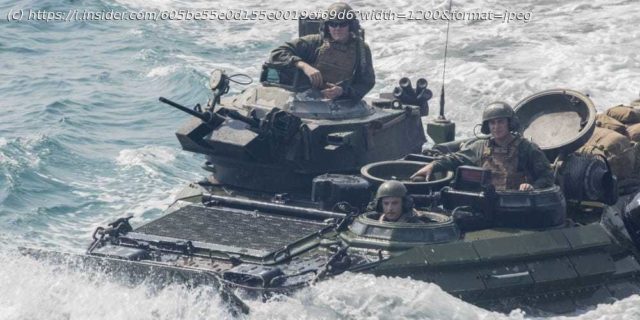Subscriber Account active
since
The US Marine Corps assault amphibious vehicle (AAV) accident last summer that killed nine service members was a disaster, one in …
Subscriber Account active since The US Marine Corps assault amphibious vehicle (AAV) accident last summer that killed nine service members was a disaster, one in which failure after failure led to tragedy, a newly-released investigation has revealed. A lot of things went wrong. At one point, just minutes before the vehicle sank, troops on board were using their cell phones as flashlights to try and open one of the escape hatches because the emergency lighting system wasn’t working. That was just one of many problems the investigation found. An AAV is a heavy fully-tracked amphibious landing vehicle commonly known as an „amtrac“ or „track“ that transports as many as two dozen troops between ships at sea and shore. Last July, an AAV assigned to Bravo Company, Battalion Landing Team 1st Battalion,4th Marines, part of the 15th Marine Expeditionary Unit, sank off the coast of California as it returned to the amphibious transport dock USS Somerset from San Clemente Island. The mishap vehicle was carrying three AAV crewmembers,12 Marines, and one Navy corpsman. Eight embarked Marines and the Navy sailor died, making this incident the deadliest AAV training accident in the vehicle’s history. In the aftermath, the Marine Corps grounded its entire fleet of AAVs as it launched an investigation into exactly what happened. Waterborne operations have yet to resume. The commander of US Marine Corps Pacific blamed the sinking and the resulting deaths on „a confluence of human and mechanical failures“ in a statement attached to the investigation. He added that „this tragic mishap was preventable.“ The command investigation found that the accident was caused by maintenance failures, delayed evacuation orders, and a failure to properly train embarked personnel on AAV safety procedures, among other issues. As the 26-ton amphibious vehicle returned to the Somerset following a shore exercise on July 30, water was leaking into the hull of the AAV from multiple locations. All AAVs leak, but more water than normal was leaking in due to various maintenance failings. Around 5:30 p.m. local time, the rear crewman informed the vehicle commander that the water inside the AAV had reached the deck plate. The commander is said to have replied: „Thanks for letting me know.“ Standard operating procedure is that embarked personnel prepare for water operations when water hits the deck plate. Evacuation should begin when water reaches boot ankle level, but that did not happen and the results were fatal. In addition to multiple watertight integrity failures, the vehicle also suffered several other serious mechanical failures, from the transmission to the generator, which impacted the four bilge pumps in place to push water out of the vehicle.






